Short Book Reviews
Hanna Kryszewska, Poland
Hanna Kryszewska is a teacher, teacher trainer, trainer of trainers. She is a senior lecturer at the University of Gdańsk, and EU Teacher Training College where she trains pre-service teachers. She is co-author of resource books: Learner Based Teaching, OUP, Towards Teaching, Heinemann, The Standby Book, CUP, Language Activities for Teenagers, CUP, The Company Words Keep, DELTA Publishing, and a course book series for secondary schools: ForMat, Macmillan. She is also co-author of a video based teacher training course: Observing English Lessons. Hania is a Pilgrims trainer and editor of HLT Magazine.
E-mail: hania.kryszewska@pilgrims.co.uk

Learning Stars 2. Pupil’s Book. J. Perrett and J. Leighton. (2014) Macmillan. ISBN 978-0-230-45578, pp.64. Learning Stars is a three level English language course aimed at learners at pre-primary level aged 2-5. The course prepares children for school both in terms of knowledge as well as skills necessary for full-time schooling. The course introduces children to reading and writing using a phonics programme. Learning Stars 2 consists of 10 units devoted to such topics as: the house, everyday activities, food, animals in the zoo, the weekend, my town, clothes, jobs and transport. In each unit there are sections on phonics and writing, vocabulary and grammar/language structures, developing concepts (e.g. clean vs dirty, identifying favourite food, discriminating between places, expressing feelings), life skills (e.g. getting ready, getting up on time, wearing a seatbelt), songs and chants, basic math skills, cross curricular themes including PSHE (Personal, Social and Health Education), and elements of story telling and drama. Each unit also includes a review section. The stories are entertaining, the songs and chants are memorable and lively, the arts and crafts activities are fun and not too complex, and the games are fun. The artwork in the book is pleasant to the eye, and includes drawings combined with some real life photography. The course is suitable for schools or countries where a text free period is not imposed in pre-school education. The course is complete with a digibook of the pupil’s book, an activity book, a maths book, a teacher’s guide pack, and an animated handwriting tool to model correct letter and number formation. Hopefully, the latter are adjusted to the norms promoted by educational bodies in individual countries. Overall the course is innovative and inspiring.
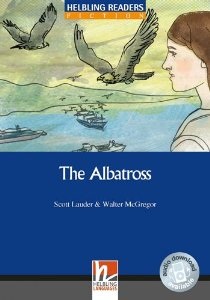
The Albatross. Helbling Readers Fiction. S. Lauder and W. McGregor. Helbling Languages (2014). ISBN-978-3-85272-789-9, pp 80. Books in this new series of graded reading materials for teenagers come at five levels. The Albatros is pitched at level 5 ( B1 Threshold/ PET). A significant part of this mystery story takes place on board a cargo ship. The readers learn about the different parts of the ship and the people who work there. One of them is Levy, an old Greek sailor, who works on board of The Albatros. This is his last assignment, which is not that smooth. He discovers some mystery about the cargo and tells the captain about it. Molly, a teenager, is the second main character. She finds a body on the beach. However, the body disappears in mysterious circumstances. The fates of Levi and Molly get interwoven. The story is a good read and it has a message for the readers. The learners become familiar with some lexis in the pre-reading tasks. As they read the story they can see the new words marked with a dot (and explained at the bottom of the page); they can also listen to the whole story and do some activities available on an accompanying audio CD. Finally there are some after reading activities. The illustrations are pleasant to the eye. I am sure the book will be popular among young learners as additional reading material, just like the other titles in the series. For more on the series go to Short Book Reviews October 2013
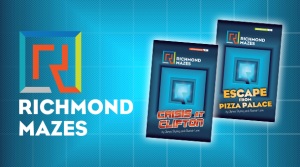
Richmond Mazes. Escape from Pizza Place and Crisis at Clifton. J. Styring and A. Lane. Richmond. (2014). ISBN 978-84-668-1743-1, pp 120. ISBN 978-84-668-1851-3, pp 200 (respectively). These are new interesting interactive readers set in a variety of contexts with lively characters. The stories are engaging and keep the readers entertained, the language is graded to suit the students’ levels. As the students read the text they have to make decisions and see or choose how the story will develop. Sometimes the clues refer to the plot e.g. decide to answer the phone or not, sometimes to strategic decisions e.g. in a work related situation: ask for more hours or continue working flexible hours. This interactive approach puts the readers in control of how the story develops. Sometimes they have to retrace their steps as they reach a dead end, or may want to go back in the story to make a different decision. This gives the learners a lot of opportunities to re-read the story and work on language revision and reinforcement. The idea of reading mazes is not a new one (e.g. The Busting of Frankie da Mora. Storytails. A, Sharp, OUP 1986) but the authors and the publisher have revived the idea using many more options, using a more lively and interactive format including apps which make the story much more interactive and gripping.
For more go to:
https://itunes.apple.com/gb/app/richmond-mazes-escape-from/id824767065?mt=8
https://itunes.apple.com/gb/app/richmond-mazes-crisis-at-clifton/id844164259?mt=8

Macmillan Readers: England. R. Blandon. (2013). ISBN 978-023-0-43642-8, pp 100; The United States of America. C. Degnan-Veness with C. Veness. (2013). ISBN 978-023-0-43641-1, pp 9; Brazil. S. Holden. (2013). ISBN 978-0-230-45419-4, pp 92; China. J. Gascoigne. (2014). ISBN 978-0-230- 46040-9, pp 96. The Macmillar Readers series is well established. It provides a variety of extensive reading texts at six levels. Some of the titles are retold versions of classics or popular modern titles others are stories specially written for the series. These four titles are slightly different. They are factual readers devoted to individual countries (I hope the publisher is planning to publish books on Scotland, Northern Ireland and Wales, not just England). The readers come at various levels England – pre-intermediate, The United States of America – pre-intermediate, Brazil – elementary, and China – intermediate. The readers do not follow the same template; some focus more on history, others on geography, culture or tradition. The readers are informative, beautifully illustrated with good quality photographs and a pleasure to read. They come with extra grammar and vocabulary exercises, some comprehension questions, a glossary of difficult vocabulary and useful phrases, an audio CD (or audio download to be bought), free resources online with worksheets, tests and answer keys. The readers are a very good way to introduce CLIL and culture elements to ELT classes.`
For more read Reviews of The United States of America and England
and
Three New Readers from Macmillan by Neil Mcbeath.

Beyond: Student’s Book Pack A2 and Student’s Book Pack B1. R. Campbell, R. Metcalf and R. Robb Benne. Macmillan. (this edition 2014). ISBN 978-0-230-46122-2, pp144, ISBN 978-0-230-46133-8, pp144 (respectively). This is a new edition of the Beyond course, which is a six level course for teenagers from A1 to B2. It offers a comprehensive syllabus including the four language skills as well as language learning strategies. The topics are meaningful and relevant to the learners which motivates and ensures success. The course has a strong productive skills focus with emphasis on writing and speaking. The latter is supported by a specially produced video which assists the learning process and makes it more real as it is set in real-life contexts. The course offers regular recycling, revision and consolidation of input. The course is supported for the learners by an online workbook, a student’s book to accompany the audio and video materials, extra listening, worksheets. For the teacher there is an online resource centre with a presentation kit, an online workbook, a course audio and video, CLIL materials including skills and culture worksheets, and access to resources available on onestopenglish.com. The course is visually pleasing, although the colour scheme is relatively pale and some pages are devoid of any visual material.
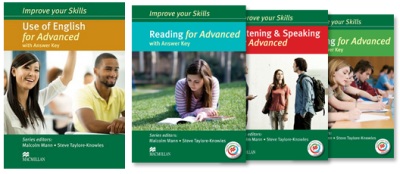
Improve your Skills. Series editors M. Mann and S. Taylore-Knowles. (2014)Macmillan. Use of English for Advanced. ISBN 9780230462052 pp. 112. Reading for Adavnced. ISBN 9780230462007 pp.112. Listening & Speaking for Advanced. ISBN 97802304642830 pp. 142. Writing for Advanced. ISBN 9780230462021 pp116. This is a four book series for learners who are preparing for the Cambridge Advanced exam. Each of the books contains an introduction to the given part or parts of the exam it is devoted to, and then is divided into twelve topic based units which provide or revise the language and grammar, and develop the skills necessary to perform well in the exam. For example in Use of English for Advanced the learners become familiar with the role of phrases and idioms, phrasal verbs, collocations, recognising parts of speech in word building etc. so as to be able to choose the correct answer in the test. In Reading for Advanced they work on understanding attitude and opinion, reading for specific information, deducing the meaning of unfamiliar lexical items, understanding text structure, or understanding implication. In Listening & Speaking for Advanced they work on listening for specific information, listening for gist, or taking notes. In the speaking part they work on the various aspects of the oral exam such as evaluating and suggesting, expressing possibility and hypothesis, and speculating. In Writing for First they work on improving their exam performance by planning, evaluating and prioritising, using paragraphs, or understanding purpose and the target reader. Each of the books comes with an access code to the Macmillan Practice Online website. The series can be used in class or as self-study material if the student has access to the edition with the answer key.
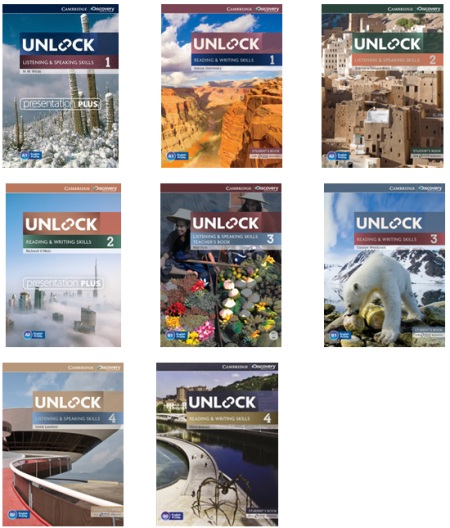
Unlock. Student’s Book. Oxford University Press. (2014)
Unlock Listening & Speaking Skills 1. N. M. White. ISBN 978-1-107-67810-1, pp222.
Unlock Reading & Writing Skills 1. S. Ostrowska. ISBN 978-1-107-61399-7, pp 206.
Unlock Listening & Speaking Skills 2. S. Dimond-Bayir. ISBN 978-1-107-68323-0, pp 224.
Unlock Reading & Writing Skills 2. R. O’Neill. ISBN 978-1-107-61400-0, pp 208.
Unlock Listening & Speaking Skills 3. S. Ostrowska. ISBN 978-1-107-68728-8, pp 222.
Unlock Reading & Writing Skills 3. C. Westbrook. ISBN 978-1-107-61526-7, pp 208.
Unlock Listening & Speaking Skills 4. L. Lansford. ISBN 978-1-107-63461-9, pp 224.
Unlock Reading & Writing Skills 4. C. Sowton. ISBN978-1-107-61525-0, pp 208.
Unlock is a new course for young adults who would like to take the IELTS exam and perfect language skills which will help them to study in English at university level. There are four levels of the course ranging from A1 to B2. Students who successfully complete Level 4 should get grades 5.0-6.5 in the IELTS exam. At each level there are two coursebooks: Listening & Speaking Skills and Reading & Writing Skills which apart from the skills mentioned in the title, also focus on vocabulary and grammar. The wealth of the material makes the course suitable for intensive IELTS preparation. The language skills which the books focus on, are not only specifically the skills which are needed to succeed at IELTS but also those vital when studying in English, eg. listening for detail, taking notes, listening for main ideas, making an opening statement for a debate, taking turns in a discussion, outlining a topic, reading for details, predicting content, making inferences from the text, working on punctuation, writing an introduction and conclusion, writing a topic sentence, editing and proofreading. There are two regular sections in each unit that truly stand out. The introduction to each unit involves watching a documentary style video from Discovery Education which tunes the learners into the topic, activates the learners’ awareness of the topic and interest in the subject. It also adds to the authenticity of the treatment of the subject. The other section that stands out is devoted to critical thinking. This section helps the learners to evaluate the importance of information, identify the structure of a description, to understand a diagram, to compare requirements to solutions, or to understand data in a line graph, just to name a few. The language presented in the course comes from the research into the the Cambridge English Corpus. Also the research into the learners’ corpus has helped to structure the writing and speaking sections, with focus on the most common errors. This is a truly innovative course.
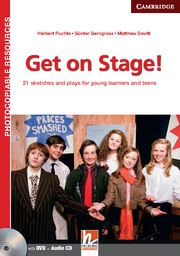
Get on Stage!21 sketches and plays for young learners and teens. H. Puchta, G. Gerngross and M. Devitt. (2012). ISBN 978-3-85272-248-1, pp 224. This book was published in the Photocopiacle Resource Series which is written by leading ELT authors. It offers ready to use creative material ready to use the classroom. The photocopiable materials for the learners are accompanied by detailed notes for the teachers on how to conduct the activity in class. Get on Stage! offers twenty one sketches and plays which are of varying length. The sketches are short or medium length, while the plays are medium length. The sketches refer to family life (The Perfect Son), shopping (Smart Shoppers), health (At the Doctor’s), or holiday (On Holiday in Rome); the plays are based on traditional stories such as The Wise Women, The Children and the Wind, or Rusty Nail Soup. The book also contains three teenage dramas: Good Girl, The Bully, and Frendship. The sketches, plays and dramas are entertaining and will motivate and engage the learners. Depending on the length and complexity, between 2 to 12 ‘actors’ are involved. The teacher’s notes are very informative; they state the number of roles in the play, runtime, sets and props which are needed, the style or character of the text, synopisis, language level, language areas, stage tips and materials needed. The book is accompanied by a DVD which contains videos of three sample plays, audio recordings of eleven plays and a film of co-author Matthew Devitt, a professional actor and director, rehersing a play with a group of students.
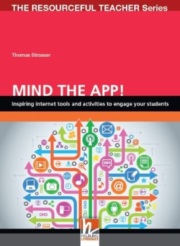
Mind the APP! T. Strasser. (2012). ISBN 978-3-85272-556-7. Helbling Languages, pp 206. The book was published in The Resourceful Teacher series which established its reputation as a series which combines classroom routines with innovative and creative techniques. It addresses various issues and presents how new developments in linguistics, pedagogy and cognitive psychology can be practically implemented to enrich and deepen classroom practice. The author of the book is a teacher, teacher trainer and a researcher of new technologies, which is a perfect combination for this kind of book. The book introduces teachers and their learners to some of the most useful and interesting web applications which enrich our teaching and motivate the learners. The various apps are presented in a clear easy to follow step by step sequences and the numerous screenshots help the visual teachers to follow the stages of the procedure. The author shows how each application can be used in a variety of ways. The book contains around forty apps which fall into five categories: teacher tools, visualisation, collaboration, audio, and writing. The Mind the App! Webiste includes video tutorials excusively produced for the apps from the book and regularly updated app links referred to in the book.
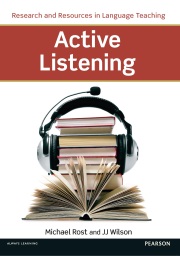
Active Listening. M. Rost and J. J. Wilson. Pearson (2013). ISBN 978-1-4082-9685-1. pp 338. This book is published in the new Research and Resources in Language Teaching series, eds. Jill Hadfield and Christopher. N. Candlin. It is a ground breaking series which combines the most recent research and state of the art classroom practice. Listening in general is a very complex skill which involves ‘prediction, inference, reflection, constructive recall, and often direct interaction with speakers’. These days listening poses more challenges as many new technologies and communication platforms offer more opportunities for input. This abundance is a great opportunity, however, there are a number of problems which arise: how to choose the right input, how to make the most of the listening (often combined with the visual input) and how to incorporate the available resources into the syllabus. First the book presents the most important aspects of research on listening in the last twenty years. It includes the following aspect of the theoretical framework: affect, top down approach, bottom up approach, interaction and autonomy (Part I - From Research to Implications). Part II (From Implications to Application) presents 50 illustrative activities devoted to the five aspects of the theoretical framework. Part III ( From Application to Implementation) is devoted to various aspects of curriculim design with regard to listening. Finally Part IV (From Implementation to Research) considers various issues regarding action research addressing the five aspect of the theoretical framework. Fourteen audio recordings of the transcripts referred to in the book are available at www.pearsoned.co.uk/rostwilson

Please check the Methodology and Language for Primary Teachers course at Pilgrims website.
Please check the Methodology and Language for Secondary Teachers course at Pilgrims website.
Please check the Teaching Advanced Students course at Pilgrims website.
Please check the CLIL for Secondary Teachers course at Pilgrims website.
Please check the Creative Methodology for the Classroom course at Pilgrims website.
Please check the Drama Techniques for Creative Language Teaching course at Pilgrims website.
Please check the Using Mobile Technology course at Pilgrims website.
Please check the ICT - Using Technology in the Classroom – Level 1 course at Pilgrims website.
Please check the ICT - Using Technology in the Classroom – Level 2 course at Pilgrims website.
Please check the Using Interactive Whiteboards course at Pilgrims website.
Please check the British Life, Language and Culture course at Pilgrims website.
Please check the How to be a Teacher Trainer course at Pilgrims website.


|